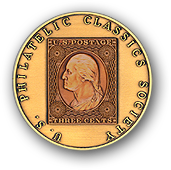With the immense array of 1851 – 1857 3¢ imperforate stamp printing varieties, naturally comes the desire for the specialist to acquire and study a variety of specimens. This statistical review of the plate and color varieties expands on Dr. Chase’s work to put scarcity in better perspective relative to catalog value.
| ESTIMATED NUMBER OF IMPRESSIONS FROM THE NINE “IMPERFORATE” PLATES | ||||||||||
| PLATE | EARLIEST KNOWN USE | MONTHS IN SERVICE | POSSIBLE COLORS 1 |
TOTAL IMPRESSIONS 2 | PERFORATED | % PERF. | IMPERF. | % IMPERF. | CATALOG VALUE 3 | |
|---|---|---|---|---|---|---|---|---|---|---|
| 1e | 07/01/51 | 1.5 | Orange Brown | 2,267,800 | 0 | N/A | 2,267,800 | 0.57% | $200.00 | |
| 1i | 07/12/51 | 2.5 | Orange Brown | 4,050,200 | 0 | N/A | 4,050,200 | 1.01% | $200.00 | |
| 5e | 07/19/51 | 3.5 | Orange Brown | 5,093,600 | 0 | N/A | 5,093,600 | 1.27% | $150.00 | |
| 2e | 07/23/51 | 3.5 | Orange Brown | 4,169,800 | 0 | N/A | 4,169,800 | 1.04% | $150.00 | |
| 0 | 09/08/51 | 3.0 | Orange Brown | 4,361,800 | 0 | N/A | 4,361,800 | 1.09% | $150.00 | |
| 1L | 10/04/51 | 41.0 | Experimental Orange Brown/Red | 61,695,000 | 0 | N/A | 61,695,000 | 15.38% | $15.00 | |
| 2L | 01/12/52 | 62.0 | Red | 85,730,800 | 484,600 | 0.12% | 85,246,200 | 21.26% | $15.00 | |
| 3 | 01/15/52 | 60.0 | Red | 78,362,200 | 484,600 | 0.12% | 77,877,600 | 19.42% | $15.00 | |
| 4 | 03/31/55 | 23.0 | Red | 45,347,800 | 7,751,200 | 1.93% | 37,596,600 | 9.38% | $15.00 | |
| 5L | 09/03/55 | 17.0 | Red | 21,151,000 | 581,200 | 0.14% | 20,569,800 | 5.13% | $15.00 | |
| 6 | 02/18/56 | 17.0 | Red | 28,962,200 | 7,751,200 | 1.93% | 21,211,000 | 5.29% | $15.00 | |
| 7 | 02/13/56 | 17.0 | Red | 36,713,400 | 15,502,400 | 3.87% | 21,211,000 | 5.29% | $15.00 | |
| 8 | 04/14/56 | 14.0 | Red | 23,122,800 | 6,201,000 | 1.55% | 16,921,800 | 4.22% | $15.00 | |
| TOTALS | 401,028,400 | 38,756,200 | 9.66% | 362,272,200 | 90.34% | |||||
1. The “imperforate” plates that did not exclusively produce the orange brown impressions are commonly referred to as the “red” plates. Plate 1L is included among the “red” plates, although it did produce the transitional “experimental orange brown” color. 2. Total impressions from each plate extrapolated by Carroll Chase from his holding of 5,100 imperforate 3-cent stamps in pairs, strips, and blocks. 3. Catalog values (as of 2010 Scott’s) don’t take color premiums into account. |
||||||||||


